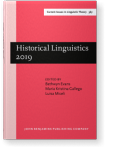Chapter 3
Phylogenetic signal in the lexicon
Are parental terms influenced by baby talk?
It has long been known that parental terms are poor indicators of shared genetic relationship because of
their tendency to be influenced by features of “baby-talk”. However, change and stability of parental terms within language
families has not been closely studied. Here I evaluate the stability of ‘mother’ and ‘father’ across three large language
families. While terms which show features of child-directed speech do appear to show fewer signs of phylogenetic signal, very
few of the results reach statistical significance. Though there is probably some influence of acquisition, it is not enough to
swamp regular transmission and other processes of change. Therefore, while parental terms are inappropriate evidence for
detecting remote relationships, such terms can be safely used in reconstruction.
Article outline
- 1.Introduction
- 2.Data
- 3.Methods
- 4.Results
- 4.1Principal components analysis
- 4.2Phylogenetic signal
- 4.3Phonological features
- 5.Conclusions
-
Acknowledgements
-
Notes
-
References
This content is being prepared for publication; it may be subject to changes.
